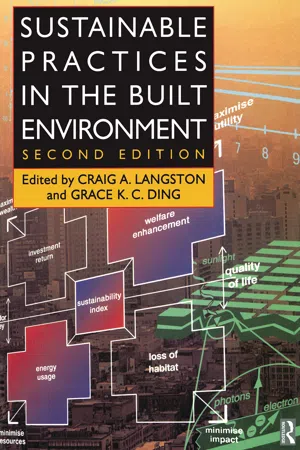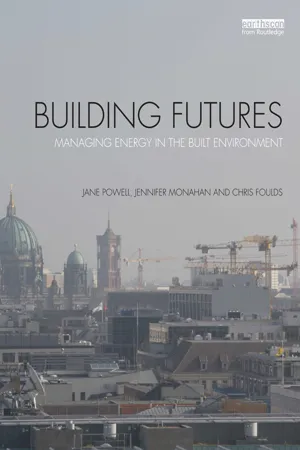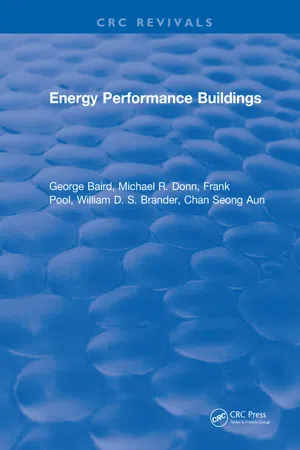Embodied Energy
Embodied energy refers to the total energy consumed in the production, transportation, and disposal of a product or material. It encompasses the energy used in extracting raw materials, manufacturing, and assembling the product. Understanding embodied energy is crucial for assessing the environmental impact of a technology or engineering project and making informed decisions about resource use and sustainability.
7 Key excerpts on "Embodied Energy"
- eBook - ePub
- Craig Langston, Craig Langston(Authors)
- 2008(Publication Date)
- Routledge(Publisher)
...Thus, they are not as ‘green’ as many would wish them to be. 15.3 Embodied Energy Most commonly Embodied Energy is defined as ‘the energy consumed in all activities necessary to support a process, including upstream processes’ (Treloar, 1997, p. 375). Embodied Energy is divided into two components, the direct energy requirement and the indirect energy requirement. Direct energy includes the inputs of energy purchased from producers used directly in a process (including, in the case of a building, the energy to construct it). Indirect energy includes the energy embodied in inputs of goods and services to a process, as well as the energy embodied in upstream inputs to those processes (Treloar, 1997, p. 376). Our interest in Embodied Energy in relation to the built environment concerns the flows of energy through buildings and their individual components and systems over their life cycle. Strategies aimed at minimizing the energy consumption of buildings has to date been focused on operational considerations, however this focus alone will not affect maximum mitigation of fossil fuel use. Further consideration is necessary of the impact of energy embodied within the specific processes related to the production, manufacture, construction, demolition and disposal of products and services related to buildings. Traditional thinking dictated that the Embodied Energy of building construction was relatively small compared with the energy used in its operational life. Contemporary research has now demonstrated that Embodied Energy can actually comprise up to 50% of the total energy flows of a building over its life cycle (Adalberth, 1994 ; Pullen, 1996 ; Treloar, 1996b ; Mackley, 1998 and 1999). The term used to describe the quantification of life cycle energy flows is energy life cycle analysis (ELCA)...
- eBook - ePub
Sustainable Construction Technologies
Life-Cycle Assessment
- Vivian Y. Tam, Khoa N. Le(Authors)
- 2019(Publication Date)
- Butterworth-Heinemann(Publisher)
...Also, the design guidelines, performance targets, and tools in this area are less developed. 5.2.1 Embodied Energy Embodied Energy is used differently in the literature based on the stages of building life cycle that are included in its definition. Most literature approach Embodied Energy from a cradle-to-gate perspective and estimate it as the summation of the energy that is consumed directly or indirectly for production of construction materials used in a building (Dixit et al., 2010). This approach to Embodied Energy only incorporates the preconstruction stage (i.e., extraction of materials, manufacturing of products, components, and systems) of building life cycle. Some other literatures expand this definition to cradle-to-site, and incorporate both preconstruction and construction stages of the life cycle, and the associated transportation (Hammond and Jones, 2008). A more comprehensive definition of Embodied Energy is based on cradle-to-grave scope, which includes not only preconstruction and construction stages but also maintenance, demolition, and disposal stages of the building life cycle. This cradle-to-grave approach to Embodied Energy defines it as the total energy used in the entire life cycle of a building, excluding the energy that is used for the operation of building. Based on this approach, Embodied Energy is the summation of initial, recurring, and demolition embodied energies (Yohanis and Norton, 2002). Initial Embodied Energy is the total energy that is consumed to extract raw materials, manufacture and transport products and components, and construct a building. Recurring Embodied Energy is the energy that is required to maintain a building and repair or replace its materials and components. The research and practice on Embodied Energy are gaining more interest in recent years, especially because the share of Embodied Energy in life cycle energy use is increasing as more high-performance energy efficient buildings are being built...
- eBook - ePub
Sustainable Landscape Construction, Third Edition
A Guide to Green Building Outdoors
- Kim Sorvig, J. William Thompson(Authors)
- 2018(Publication Date)
- Island Press(Publisher)
...Between each step, the material may be transported, at an energy cost. Transport from factory to construction site also uses energy. Embodied Energy sums up all these energy inputs, usually in terms of energy per pound (or other unit) of material. Energy costs of disposing or recycling the material are important, but sometimes neglected, in Embodied Energy. For a whole construction project, Embodied Energy totals all energy inputs for materials, processes, and waste. Embodied Energy has a number of synonyms: embedded energy, process energy (which emphasizes factory processes and often excludes transportation), and energy intensity. Energy intensity emphasizes the relative level of energy required to produce a unit (weight, volume, size, etc.) of material. The same term, unfortunately, is used by the US Department of Energy and others to mean the amount of energy used to produce a dollar’s worth of product. 7 Although this energy-per-dollar idea has its own uses, it should never be confused with energy-per- material figures. Architects have also used “energy intensity” to mean per-square-foot operating energy of buildings. 8 Because of these confusions, “Embodied Energy” seems the most consistent term for energy in materials production. Differentiate Energy in Buildings versus Landscapes In buildings, large amounts of energy are used for operation ; 60 percent of the running costs of the building can readily be saved through efficiency in heating and cooling. 9 There is a trade-off, however: improved operating efficiency usually requires up-front investment in better construction and materials. Low-cost developments, for example, skimp on insulation to keep sale prices low; increased heating and cooling bills are the result. For poorly insulated houses, operating energy costs are so high that total energy to produce the structure is only about nine times the energy to operate the building for a year...
- eBook - ePub
Building Futures
Managing energy in the built environment
- Jane Powell, Jennifer Monahan, Chris Foulds(Authors)
- 2015(Publication Date)
- Routledge(Publisher)
...Hotspots refer to areas for which improved material choice and/or manufacturing practices can reduce energy consumption and remove unnecessary harmful environmental impacts. In summary, the relative importance of Embodied Energy increases as buildings become more energy efficient. By focusing on reducing operational energy, only part of the whole picture is considered. Not only does neglecting to account for Embodied Energy represent a lost opportunity for reducing the environmental impacts of the built environment, it may also have the unintended consequence of increasing the use of energy-hungry and carbon-intensive products, such as plastics in high-performance insulation products. The resulting allocation of resources, when considered over the whole lifetime of a building, may not actually achieve overarching energy and environmental goals. In this chapter we introduce the principal concepts involved in understanding Embodied Energy. In particular, we focus on the methodological approaches used to quantify the Embodied Energy associated with a building over its whole lifetime. We provide suggestions for changes that can be made to reduce Embodied Energy so as to lower the lifecycle energy and the carbon of buildings. The implications of using ‘natural’ construction materials are also explored. 3.2 The lifecycle of buildings Energy is used and emissions occur at all points in the lifecycle stages of a building. The lifecycle of a building is typically viewed linearly, beginning with the extraction of raw materials and ending with demolition and waste management at end-of-life (Figure 3.1). This includes the exploration, finding and extraction of raw materials (e.g. forestry, mining of ores). These are then manufactured into materials, products and components that are transported from the place of manufacture to the construction site. During construction, energy is used in various activities and processes required in constructing the building (e.g...
- eBook - ePub
- George Baird(Author)
- 2018(Publication Date)
- CRC Press(Publisher)
...In the case of double glazing, on the other hand, the period needed to balance the capital energy requirement could exceed the useful life of the building, even though the cost payback time is very much less. In this latter type of case, national energy planners may wish to regulate the choices of materials or components in order, for instance, to reduce the demand for a particular form of energy (which may be an essential input to the manufacturing process for a given material) or simply to reduce energy demand in general. Hence, this chapter is of relevance at the national level as well as to building designers. The concept of Embodied Energy is considered first. The terminology and conventions in energy analysis and its limitations are also considered. Following that, the energy consumed by the construction industries of two countries, the U.S. and New Zealand, are examined and compared. The processes involved and the energy consumed in the manufacture of some common building materials is then studied and the energy coefficients of these building materials are presented. The application of these energy coefficients, to the estimation of the energy requirements of building components and of a standard house, is then illustrated. The chapter ends with a brief outline of possible design applications and opportunities for the use of energy analysis. II. The Concept of Embodied Energy To embody is to “cause to become part of body", or to incorporate or invest. The Embodied Energy of a product is the sum total of all the energy incorporated or invested, throughout the various stages of manufacture, from raw material to finished product. This section will outline the methods and conventions for calculating Embodied Energy. The limitations of the concept in relation to human labor and to the indirect costs associated with environmental damage are also discussed. A...
- eBook - ePub
- Rob Cross, Roger Spencer(Authors)
- 2009(Publication Date)
- CSIRO PUBLISHING(Publisher)
...Embodied Energy in products is discussed in more detail, including estimates of the Embodied Energy content of materials, chemicals and fertilisers, in the chapter on garden design and Table A3 in the Appendix. Table 4.4 Energy used by machines and humans. A comparison of the time and energy used moving 20 m3 of soil 200 metres Inputs Method of moving soil 1 earthmover 8 labourers Time taken (minutes) 2 700 Fossil fuel (diesel) use (L) 3.25 0 Energy use (kJ) 127 078 30 127 Source: Adapted from Thomson & Sorvig (2002). 24 Embodied Energy can come from unlikely sources. For example, the provision of mains water (infrastructure, pumping, etc.) carries an Embodied Energy load. In Melbourne, the energy cost of water delivery to the gravity-fed home tap (excluding energy embedded in infrastructure) is 0.14 KWh/m 3. Pumped water, like that in Brisbane, is about 0.4 KWh/ m3. Seawater desalination requires about 3.5 KWh/m 3, brackish water desalination 1–1.5 KWh/m 3. The Embodied Energy of water from a proposed Wonthaggi desalination plant in Victoria will be closer to 5KWh/m 3 when the pumping energy is included. The energy for pumping water from Perth to Kalgoorlie (~560 km) is about 12 KWh/m 3. Melbourne uses about 0.6 KWh/m 3 for wastewater disposal. 25 Energy outflows Having covered the rather complicated energy inflows, outflows can be dealt with much more quickly. Energy is removed from the garden in organic matter as green waste and garden produce. Organic matter breaking down on-site releases heat of decomposition. We can regard Embodied Energy as leaving the garden when materials and products are removed (exchanged, sent to tip, given away, waste entering the sewage system, etc.), and of course energy is lost as heat when power tools and appliances are used, and as we dig. Much of the Sun’s energy is either reflected away directly, or absorbed and given off as heat. We can compare the modern garden with a pre-industrial one...
- J. K. Yates, Daniel Castro-Lacouture(Authors)
- 2018(Publication Date)
- CRC Press(Publisher)
...Each of these items has an element of energy consumption as a component, and energy reduction is a major part of sustainable designs. Energy is required at the point of material extraction; for the production of materials; when transporting materials; and during construction, operations, maintenance, and disposal. In addition, in the United States reducing energy consumption was a key element of the 2010 National Security Strategy, and this is where Embodied Energy considerations play an important role (White House 2010). One technique for reducing energy consumption is using natural lighting and louvered systems to deflect direct sunlight in the summer and allow direct sunlight into a structure during the winter. Fiber-optic cables are used to transmit natural light to areas of buildings requiring minimal lighting. Another energy reduction technique is using timers and sensors on lighting systems to turn on the lighting systems only when they are required and turn them off when there are no occupants in the structure or a room. Heating, ventilating, and air-conditioning (HVAC) systems should have the highest seasonal energy efficiency ratio (SEER) possible. Energy-efficient appliances should be specified based on their Energy Star rating. In some areas, using Energy Star appliances results in tax rebates and tax credits. Energy Star ratings are applicable to more than appliances as they also apply to HVAC systems, doors and windows, biomass stoves, insulation, hot water heaters, geothermal heat pumps, residential wind turbines, solar energy systems, and fuel cells. Structured approaches for including sustainability considerations during design are listed in Chapter 7 in Section 7.10. Information on designs, construction components, and practices with sustainable components is provided in Section 7.11...






